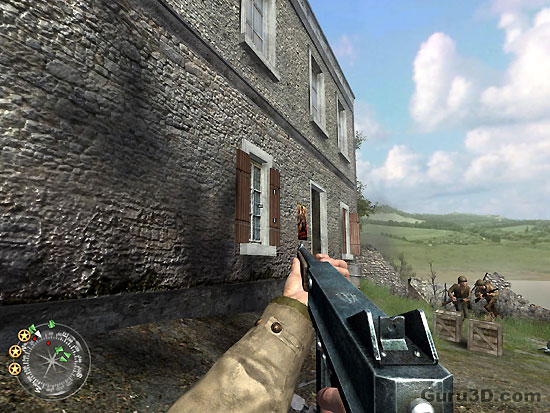Page 4
Graphics and Performance & Sound
Call of Duty II presents a completely new graphics engine from top to bottom. Gone is the rather infamous Quake III engine of old, replaced by something of real beauty. The look of COD II is all about gritty realism, (which suits the type of game) rather than the souped up hyper-real flashiness of the Doom III or FEAR engine. Presenting some of the best-looking texturing in a game along with some really beautiful effects, heat peels off the desert horizon as you ride with your comrades in a jeep towards your next objective, and explosions kick up mud and dirt from the ground as you pull yourself over the top of the cliffs at Pont du Hoc. However, the pick amongst these has to be the smoke effects. These are truly the best in any game seen so far. Your smoke grenades produce a thick blinding fog that truly provide excellent cover to help you navigate around death dealing machine guns and flank enemies, taking them by surprise.
Smoke from grenades whips realistically, and in the desert missions, blends realistically with the sand thats kicked up and drifting across the desert. Lighting effects are generally more understated than, say, in Quake IV or Doom III, but often provide moments of subtlety, especially in the British missions, and the aforementioned Russian Pipeline mission. In order to reproduce these visuals in COD IIs epic scale, a fairly hefty amount of graphics horsepower is required, particularly if you are wanting to run at high resolutions such as 1600x1200 or higher without compromise. After playing the game through twice, once equipped with a pair of 6800 Ultras, and the other a pair of the ultimate 7800GTX 512s slotted into the test rig, I had a genuine sense of the power required to run COD II. Lets start with the 6800Ultras. Up until COD II (and to an extent FEAR) these two cards were capable of running any game at 1600x1200 without breaking a sweat.
To my surprise, COD II presented them with a rather large challenge. In fact it took a considerable about of tweaking to get a stable 35fps frame rate out of them at 1600x1200. Luckily there are a numerous amount of options available in the games options menus, along with some notable console tweaks. The first thing to note, is that when AF is applied in the menu, it actually applies 8xAF which provides a significant performance hit. I had to reduce this via the console using the r_anisotropy command to 2x. AA was switched off. Then dynamic lights were turned to the medium setting, and smoke effects to 'World Only'. Only then could I get a barely playable FPS of 30-35. At 1280x1024 however, this combination flew through the game with no worries. A single 6800 ultra was able to command a playable frame rate at 1280x1024 so long as you dont expect to run AA and AF at high levels, and maybe sacrifice one or two nicer touches. You can forget any higher resolution than this though on a single card other than higher end 7800s or X1800s. After playing the game through first time, 2 7800GTX 512s miraculously turned up and found their way into the test rig (dont you just hate it when that happens?). Now, it will not be a surprise to most of you reading this that such a partnership of graphics power pummelled CODII into submission and the difference was substantial. At the same settings as the 6800Ultras, the cards were hitting around 80fps.
In fact, I was able to increase the detail settings to maximum in the options menu. I was able run at 4xAA, reset AF to 8x and even run with Transparency MSAA (SSAA gave too much of a hit to make it worth it). At these very high settings FPS seemed to hover around 50-60fps for the most part. In some sections hitting as high as 70, while in particularly heavy situations not dipping below 40. Not to mention the game looked stunning.
All pics with 4xAA 8xAF

Textures DX7 Mod

Textures low

Textures max
